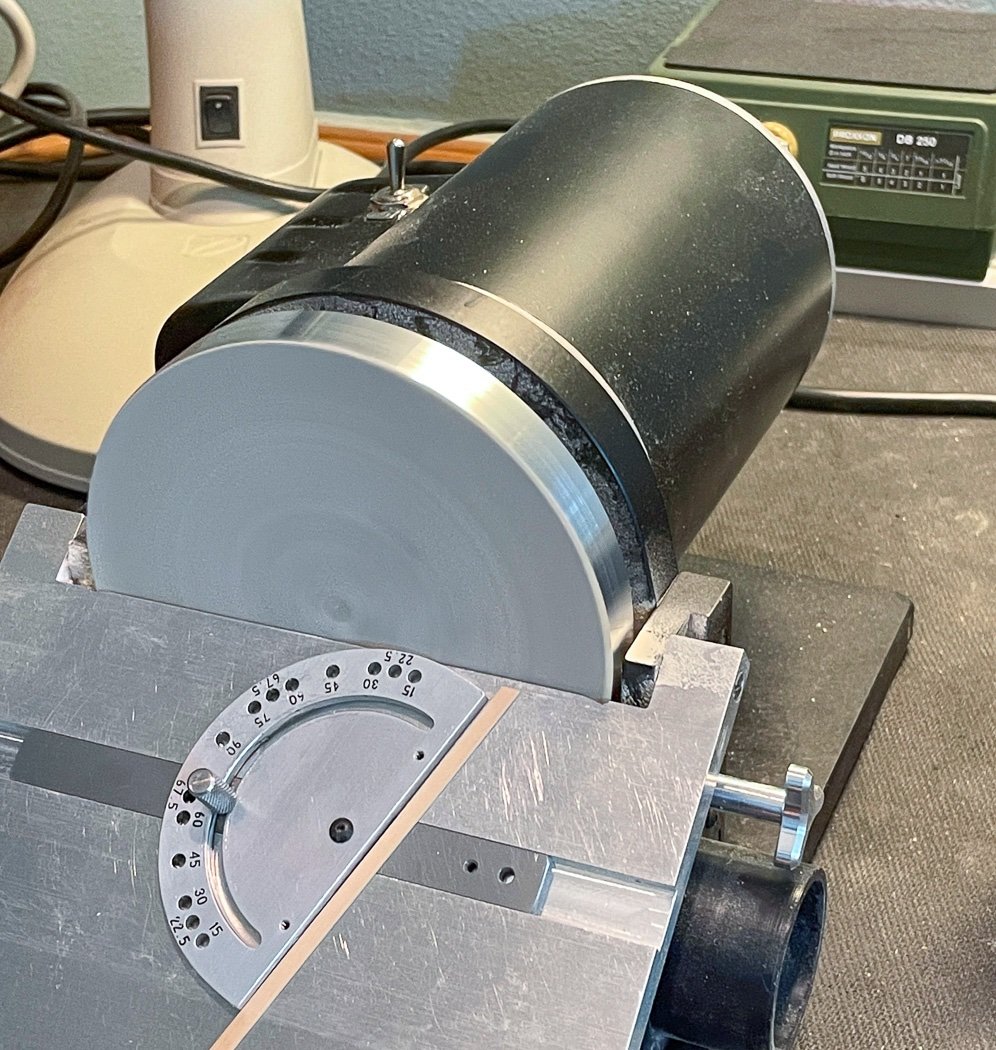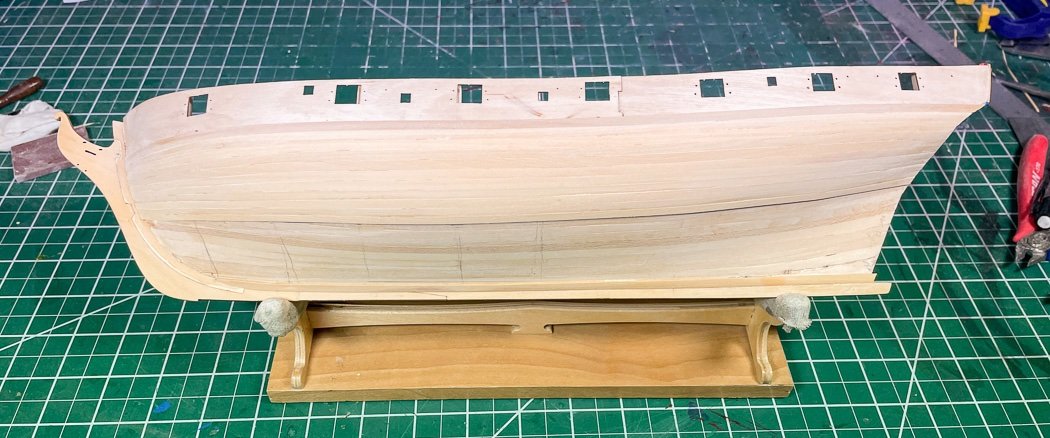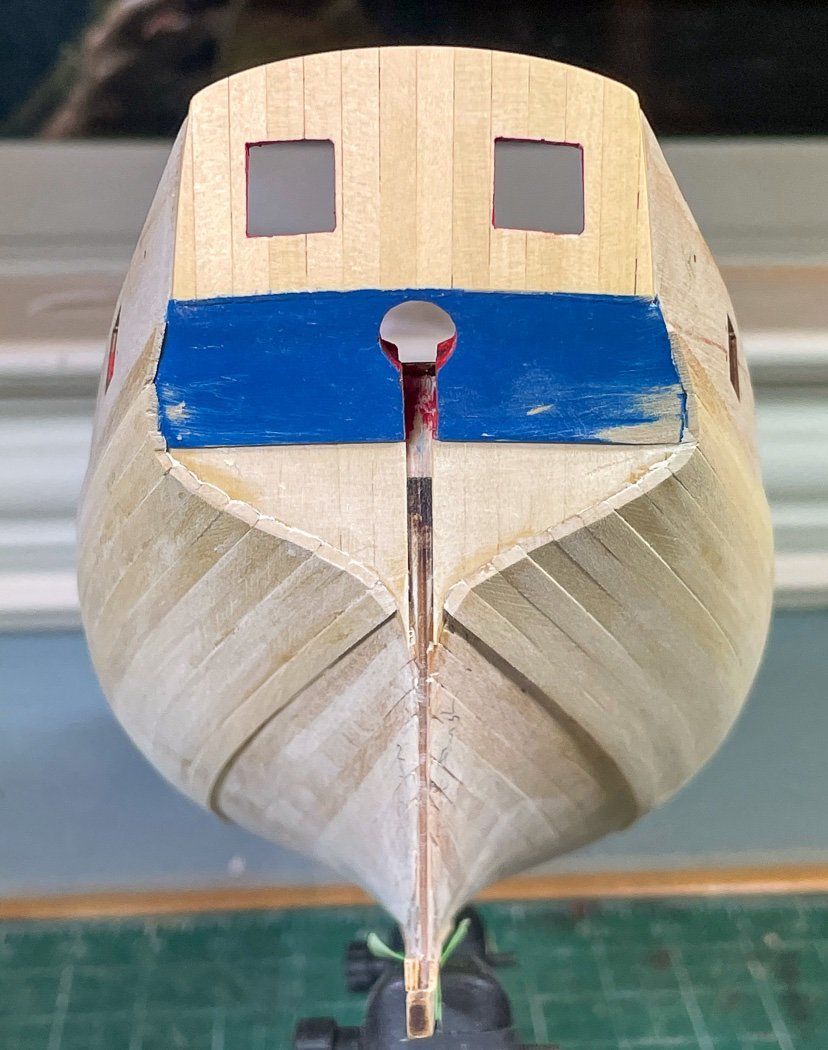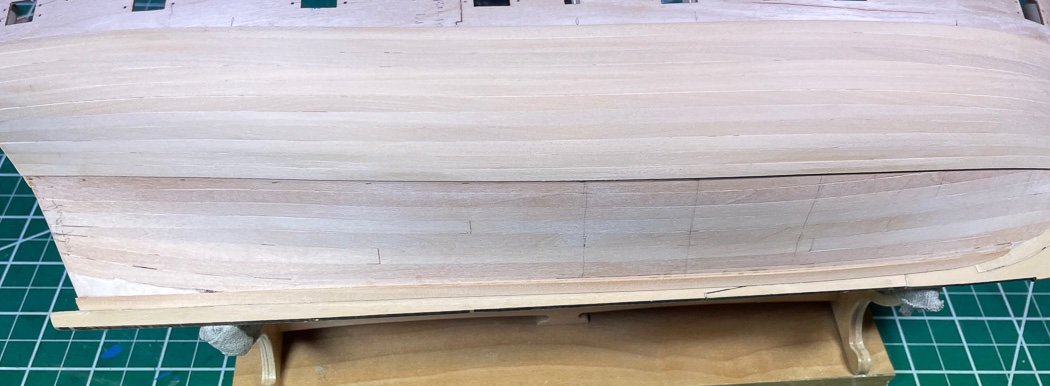-
Posts
3,844 -
Joined
-
Last visited
Content Type
Profiles
Forums
Gallery
Events
Everything posted by glbarlow
-
The wavy walnut line is a tapering issue along with plank bending shortfall. Basically you started the taper too far back from the stem. H We’ve all been there. You can paint over dry Wipe On Poly, I don’t know about oil, I wouldn’t think acrylics and oil go together
- 71 replies
-
- Lady Nelson
- Amati
-
(and 1 more)
Tagged with:
-
2nd Planking - Part 1 I’ve completed the first belt of the second planking on both port and starboard. My progress has been a bit slow because I’ve had a bit of a difficult time with Flirt. I had to work attaching the keel to address a slight warp in the former, but it and the keel are quite thin and I managed to break it off while using my Amati keel holder, this despite firmly gluing it using PVA. So a good deal of time was spent repairing that. Nonetheless I’m pleased with the result of the first band. I found the line for the first belt by determining 21 planks are required between the master plank and the keel. So I marked a line between bulkheads 7 & 8 (where full width is required at midships) ten plank widths down from the master plank and from there used artist tape to determine where to run the belt. To the stern is easy, its full width planks all the way. The bow is the artistry part, there is no magic answer, you just know it when you see it, maybe. I did better marking the second planking learning I’d marked it high on the first planking. It is wonderful affirmation to see the planks following the tick marks as I progressed. It takes time to line the hull like this, using a planking fan to determine the width at each bulkhead. I’ll say once again its time well spent. Sure there are other methods, on this model I probably could have winged it and been ok. I won’t be able to do that when I start Winchelsea some day, so I want to learn to do it right now. Once again the Byrnes Sander gets the right angle and bevel down the stem. It changes a bit with almost every plank, the sander really helps keep the planks tight to the stem. I spent some time on the garboard strake, never as easy as you’d think. One because it’s a good time to do it. After I line the lower belt I’ll add one or two planks above it and meet them coming down. More importantly in this case it added some needed support and strength to the keel. I always plank with CA, however in this case I used PVA and clamps on both garboards, they are now one with the frame. I haven't done any sanding I'll wait until the second belt is finished. The boxwood second planking looks good coming into the stern, even only rough sanded, again the plank bending including inward twists make it happen. I knew I’d chew up my painted counter some going in, it’s an easy fix later. You can see with the garboards how much sanding was required on the frame to fit the stern post. All that I did and I’ll still need a little more off the boxwood to get a good fit, really have to take that into account at the outset. The instructions aren’t kidding when he says remove wood from the frame to a 1 mm width. As I've noted before I really enjoy plank bending. Nothing more than a travel iron is needed to form the planks to fit to follow the curves and bends of the ship. It’s only rough sanded at this point, with the boxwood only 1mm thick I’ll wait until its completely planked to sand carefully sand it out. Off to finish the planking. As always, thanks for the likes and especially the comments.
-

How to seize a block to an iron band
glbarlow replied to Laggard's topic in Masting, rigging and sails
I’m going to drop out of this conversation. Best of luck to all. -
With that clamp in the middle and just the table to iron on not sure how you’re heating enough or long enough to hold the curve.
- 71 replies
-
- Lady Nelson
- Amati
-
(and 1 more)
Tagged with:
-
Just FYI, they are actually carronades 😁
- 274 replies
-
- Cheerful
- Syren Ship Model Company
-
(and 1 more)
Tagged with:
-
Thukydides has done a nice job of explaining this method. I’m an absolute believer in it being worth the time to learn above all others. It is a trial to learn but well worth the time. Once you sort it out you’ll always be able to do it and share with others how you did. In time you’ll become the teacher. The simplistic way to think about line a hull is this: The widest point of the hull determines the number of planks needed to run the length of the ship from stem to stern. First determine that with a tick strip measuring that length top to bottom, divided by the width of your planks. That number of full width planks won’t fit at the stem, and often won’t at the stern so the planks must be tapered. The requirement is when you’re done you’ll have the same number of planks at the stem as you have at midships, they’ll just be skinnier. This method tells you how skinny. Take a tick strip and measure the length of each bulkhead, place each one in turn on the planking fan aligned to the left edge and move it to where the right edges matches the line equal to the number of planks required at midships. Now you know how wide each plank has to be at each bulkhead, transfer those marks to the bulkhead as a guide and also use them to know where to taper your plank. The strip of tape marking each belt is hard because it’s not math, it’s art. It’s breaking up what I described above by dividing the hull into sections or belts to help keep you on track with your measurements by making smaller sections. For a small model you may not need it at all, for a medium size one belt will do, for a larger model maybe two or three. The art is to find the flow of the hull so the planking has a nice sweep, only by doing it and gaining experience will you learn how to get that line, or better yet looking at other build logs to see what they did. Check out my Cheerful build log to see some photos and text on how I did it. But know this, I removed and redid my planking multiple times until I got a result I liked. This technique works great, but it takes time to learn and it takes time to do. My advice is to stick with it. There are many ways to plank a ship, the only bad way is trying to merge and meld all those or skip from one to another based on other’s preferences. It can get confusing fast trying to abide by too much advice, well intentioned it might be (like the post below who seems not to have read anything above it). Stick with this one method. Good luck, hang in there. There will be that moment when it all becomes clear.
-

How to seize a block to an iron band
glbarlow replied to Laggard's topic in Masting, rigging and sails
Do you have a Quad Hands or something similar? It’s essential to have an “assistant” or third hand when rigging. You mentioned the fishing lure knot, with the third hand you can strop or seize the block and the hook and do other the knots required to do a complete job of rigging. Click Here to see options for Quad Hands on Amazon, for me it’s an essential tool. I think you’re going to have to decide if model building is something you want to do. There are ways to do things that are done by lots of modelers, there are good and bad ways, simple and overly complex ones, but mostly just different ways to accomplish the same thing. Some posters get defensive thinking only their way is the right way, others just offer an opinion forgetting it is just their opinion and not gospel. Bottom line is through all of that you need to find what works for you and practice it until you’re comfortable doing it. A first model is just that, a first model. -
The swivels are horribly out of scale, I left them off
- 71 replies
-
- Lady Nelson
- Amati
-
(and 1 more)
Tagged with:
-
I built a different version of Fair American, it’s a great ship to model. You can see it via the link in my signature if you’re interested. I have planked 10 models with CA, several are over 10 years old, it is more than strong enough and how you get planks to hold in the rabbit. You’ll find CA verses PVA an ongoing debate on this forum, I’m in the CA camp. I’d add not all CA glue is equal, common store brands aren’t the best for modeling, try Bob Smit Industries, you can find it on Amazon. I use CA for most things, White PVA for a lot of things, and Titebond only for the initial framing to answer your glue question earlier. You have struck on your own the process of Lining The Hull, good work on that. Chuck Passaro has a .pdf and some video tutorial on that and using heat for plank bending. It’s a good process and great that you basically discovered it on your own. The dividers mentioned are a good approach, I prefer tick strips, either way those and your approach the key is determining the taper needed to have a plank run stem to stern without fillers (no small feat). As Greg mentioned, though you’re past this now, the most important step in building a model is proper fairing, something many try to rush and pay the price later. Generally I work down instead of up on planking other than fitting the Garboard and and a couple of bottom planks. That way any sins I might have cover are hidden on the bottom of the hull and by paint below the waterline. From your posts it seems you are only single planking the hull? It looks like it’s lime or bass wood generally used as a first planking which is then covered by walnut (most common in kits) or some other thin veneer. If you’re going to stay with the one planking I’d highly recommend against tree nailing. More often than not it turns out bad, I’ve seen some really nice models turned ugly with the measles. I’d also recommend using Wipe On Poly on your hull, it’s a great look and will provide some definition between the planks. Just wipe it on generously the immediately wipe all you can back off for a nice Matt finish. I probably put 5 coats like than on my Cheerful with light sanding and several days of drying time between. You’re doing a great job on your first model. I’m on my 11th now and still learn something new and better from the generous people in this forum all the time. You’ve come to the right place, and sharing a build log is the best way to learn. Congratulations on your progress.
-
Two of my favorite models. The AVS was my first model, Fair American came later, I used it as an opportunity to “paint with wood”. Exotic woods were easier to obtain back then. Welcome back to modeling.
-
Agree the best approach is first sand down the planking, you have a lot of thickness there you can remove. Then thin the wales as it nears the stem to be almost equal to the planking. This in fact is how the wales are done on my Cheerful by design if you want to see an example. For your next model: you should have started tapering the planks right away and not had those full width ones there (referring to where the dark ones start, not those above deck level). Lady Nelson is a good first model, but at least in mine (done as a refresher after a three year layoff) the materials were very shoddy. Your next Vanguard model will be more fun. Use LN had a learning platform and the give it to your son. 😁
- 71 replies
-
- Lady Nelson
- Amati
-
(and 1 more)
Tagged with:
-
That’s bold to split a bulkhead. Enjoying watching this develop.
- 858 replies
-
- Sphinx
- Vanguard Models
-
(and 1 more)
Tagged with:
-
With this beautiful model I plan to do the same and agree with Mike’s call on not rigging the guns. I may include breaching ropes but that’s it. Now I get aligning all the guns, that will stand out so much more nicely without ropes all about.
- 607 replies
-
- winchelsea
- Syren Ship Model Company
-
(and 1 more)
Tagged with:
-
Well done, very crisp attention to detail and outstanding craftsmanship!
- 254 replies
-
- Medway Longboat
- Syren Ship Model Company
-
(and 1 more)
Tagged with:
-
On this forum I am confident reporting a negative comment using the report function (in the upper right corner of a post) will get that comment deleted by our moderators, and if it continues that person removed from MSW. If it’s in some other place I’m still confident our moderators will deal with it, just bring it to their attention via a direct message. I often say if I want negativity I can go to any Facebook political post, not here on MSW. Your work is excellent, your model of a type one seldom seen here. I enjoy reading how and with what tools others accomplish tasks, especially when it result in such nice results. Thanks for coming back to share it with us.
About us
Modelshipworld - Advancing Ship Modeling through Research
SSL Secured
Your security is important for us so this Website is SSL-Secured
NRG Mailing Address
Nautical Research Guild
237 South Lincoln Street
Westmont IL, 60559-1917
Model Ship World ® and the MSW logo are Registered Trademarks, and belong to the Nautical Research Guild (United States Patent and Trademark Office: No. 6,929,264 & No. 6,929,274, registered Dec. 20, 2022)
Helpful Links
About the NRG
If you enjoy building ship models that are historically accurate as well as beautiful, then The Nautical Research Guild (NRG) is just right for you.
The Guild is a non-profit educational organization whose mission is to “Advance Ship Modeling Through Research”. We provide support to our members in their efforts to raise the quality of their model ships.
The Nautical Research Guild has published our world-renowned quarterly magazine, The Nautical Research Journal, since 1955. The pages of the Journal are full of articles by accomplished ship modelers who show you how they create those exquisite details on their models, and by maritime historians who show you the correct details to build. The Journal is available in both print and digital editions. Go to the NRG web site (www.thenrg.org) to download a complimentary digital copy of the Journal. The NRG also publishes plan sets, books and compilations of back issues of the Journal and the former Ships in Scale and Model Ship Builder magazines.









